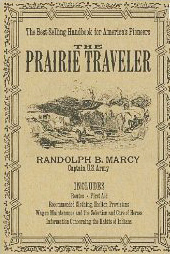 If you were headed West in the 1860s, you probably carried two bibles – one for spiritual guidance and the other one, “The Prairie Traveler
If you were headed West in the 1860s, you probably carried two bibles – one for spiritual guidance and the other one, “The Prairie Traveler” by Captain Randolph B. Marcy, for advice on all your other needs along the trail.
Published by the U.S. War Department in 1859, 16 years before the last free band of Native Americans surrendered, and billed as “The Best-Selling Handbook for American Pioneers,” Marcy’s manual covers everything from the topography of specific routes to how to supply a wagon; select a camp; track and pursue Indians; ford rivers; descend mountains; and all other vital information for such a journey.
Fascinating from an historical perspective, “The Prairie Traveler” is also packed with practical observations on the behavior of horses, mules, oxen, and wild animals.
“For prairie service,” Marcy notes, “horses which have been raised exclusively upon grass, and never been fed on grain, or ‘range horses,’ as they are called in the West, are decidedly the best, and will perform more hard labor than those that have been stabled and groomed.”
A footnote points out that a “recent” experiment at the veterinary school in Alfort (founded near Paris in 1766) discovered that horses actively exercised after being fed digested their feed within three hours, while digestion for stalled horses had “scarcely commenced” in three hours.
Mules, in Marcy’s opinion, were superior to oxen, where good grass was available, because they could travel faster on firm ground and better endure the heat of summer. For a journey of 1,500 miles or more, over rough or muddy ground, oxen were more practical and economical.
Foreshadowing inherent risks of the trail, Marcy also explained that oxen were less likely to be stampeded and driven off by Indians, and, if necessary, they could be used for beef.
On the other hand, mules were easily induced to follow a “bell mare,” and except if they got water in their ears, in which case they were “often drowned,” made excellent swimmers.
“Whenever a mule in the water drops his ears, it is a sure indication that he has water in them, and he should be taken out as soon as possible,” Marcy cautions.
Horses and mules, he also notes, make good sentinels in Indian territory, often alerting, with heads raised, the direction of approaching danger, long before a dog would notice.
When crossing Indian country, Marcy recommends being on the alert for tracks: “Mustangs….leave a trail which is sometimes difficult to distinguish from that made by a mounted party of Indians, but if a single pile of dung is found, this is a sure indication that a herd of mustangs has passed, as they always stop to relieve themselves, while a party of Indians would keep their horses in motion, and the (dung) would be scattered along the road.”
A chapter titled “The Buffalo” describes in detail two methods for hunting buffalo: running them on horseback, and stalking or still-hunting. Running them requires a fleet, fresh, and fearless mount.
“As a long buffalo chase is very severe labor upon a horse,” he points out, “I would recommend to all travelers, unless they have a good deal of surplus horse-flesh, never to expend it running buffalo.”
“The Prairie Traveler,” which includes maps of the principle routes between the Mississippi and Pacific, noting landmarks along each trail, and the availability of water, wood, and grass.
It also features a map of the Pikes Peak gold region (a major lure for travelers) and numerous illustrations, including those of saddles and tack; horse tracks; the proper technique for fording a river and swimming a horse; and ones simply titled “The Grizzly,” and “Keep Away!”
“The Prairie Traveler” is available as a free download for the Kindle e-reader on amazon.com, where the soft cover book is also available.
